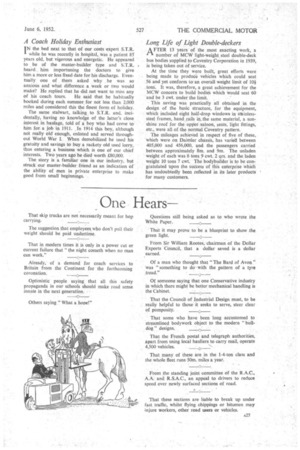Passing Comments
Page 28

Page 29

If you've noticed an error in this article please click here to report it so we can fix it.
Mechanical Splicing of Wire Ropes
THE splicing of wire ropes in the normal way
requires considerable skill and time, there is often danger of injury to the hands if great care be not taken and it is not a job relished by the operator, in addition, a considerable length of rope is usually wasted.
By using the " Talurit " equipment, manufactured and distributed by Cable Covers Ltd., St. Stephen's House, Westminster, London, S.W.1, a join much stronger than a splice can be made in less than five minutes, even on large-diameter rope and using only a few inches of material. Invented by a German refugee who entered Sweden with nothing but an idea, it was quickly developed.
The method employed is to use a special copperfree aluminium-alloy ferrule, almost lozenge-shaped in cross-section This has two inter-connecting holes through one of which the rope is passed, turned round a thimble and the end inserted into the other. The ferrule with the rope in position is then placed between specially shaped dies in a hydraulic press, the.lozenge shape being changed to round and during this process keying into the most minute interstices of the rope. Nothing but a. thin flash is left at each side and these are easily cleaned off. In.practice, a short length of the rope is first clamped into a part of the special press and the free end given a few turns, after which it is cut squEire.
" Talurit " presses range from 22 tons to 1,000 tons, with a capacity of lmm. to 40 mm., and will be available under licence to makers and users of wire ropes. To these operators will also be supplied the appropriate clamps, swages and ferrules.
Savings effected by the process are estimated at 85 per cent, material and 90 per cent. time. Ferrules of special alloy will• be available for ropes of chromium (stainless) steel.
Road Increases, Rail Decreases in U.S.A.
As is well known, a tremendous amount of r-k America's traffic is carried by road and the U.S. Interstate Commerce Commission has stated that the average distance over which freight is carried on U.S. highways by Class 1 interstate small carriers increased from 176 miles in 1945 to 217 miles in 1949. It is interesting to note that the comparable railway average decreased from 240 miles to 227.
A Coach Holiday Enthusiast
IN the bed next to that of our costs expert S.T.R. 1 while he was recently in hospital, was a patient 85 years old, but vigorous and energetic. He appeared to be of the master-builder type and S.T.R. heard him importuning the doctors to give him a more or less fixed date for his discharge. Eventually one of them asked why he was so anxious and what difference a week or two would make? He replied that he did not want to miss any of his coach tours. He said that he habitually booked during each summer for not less than 1000 miles and considered this the finest form of holiday.
The same stalwart, talking to S.T.R. and, incidentally, having no knowledge of the latter's close interest in haulage, told of a boy who had come to him for a job in 1911. In 1914 this boy, although not really old enough, enlisted and served throughout World War I. When demobilized he used his gratuity and savings to buy a rackety old used lorry, thus entering a business which is one of our chief interests. Two years ago he died worth £80,000.
The story is a familiar one in our industry, but struck our master-builder friend as an indication of the ability of men in private enterprise to make good from small beginnings.
Long Life of Light Double-deckers
AFTER 13 years of the most exacting work, a number of MCW light-weight steel double-deck bus bodies supplied to Coventry Corporation in 1939, • is being taken out of service.
At the time they were built, great efforts were being made to produce vehicles which could seat 56 and yet conform to an overall weight limit of 10i tons. It was, therefore, a great achievement for the MCW concern to build bodies which would seat 60 and be 3 cwt. under the limit.
This saving was practically all obtained in the design of the basic structure, for the equipment, which included eight half-drop windowsin stainlesssteel frames, hand rails in_the same material, a sunshine roof for the upper saloon, seats, light fittings, etc., were all of the normal Coventry pattern.
The mileages achieved in respect of five of these, • which were on Daimler chassis, has varies between 405,000 and 456,000, and the passengers carried between approximately 8m. and 9m. The unladen • weight of each was 6 tons 9 cwt. 2 qrs. and the laden weight 10 tons 7 cwt. The bodybuilder is to be congratulated Upon the success of this enterprise which has undoubtedly been reflected in its later products for many customers.
































































































